Today we’re diving into the generation that turned memes into a language, made TikTok the center of pop culture, and introduced the world to slangs like “it’s giving” and “rizz.”
Gen Z, born between 1997 and 2012, is often teased for being glued to their phones or caring too much about online trends.
But the truth is that this generation is setting the pace for how everyone else communicates, shops, and even works. From their views on money and careers to the way they interact with brands, their influence is hard to ignore.
To see what really drives them beyond the jokes and stereotypes, here are the Gen Z stats that explain who they are today.
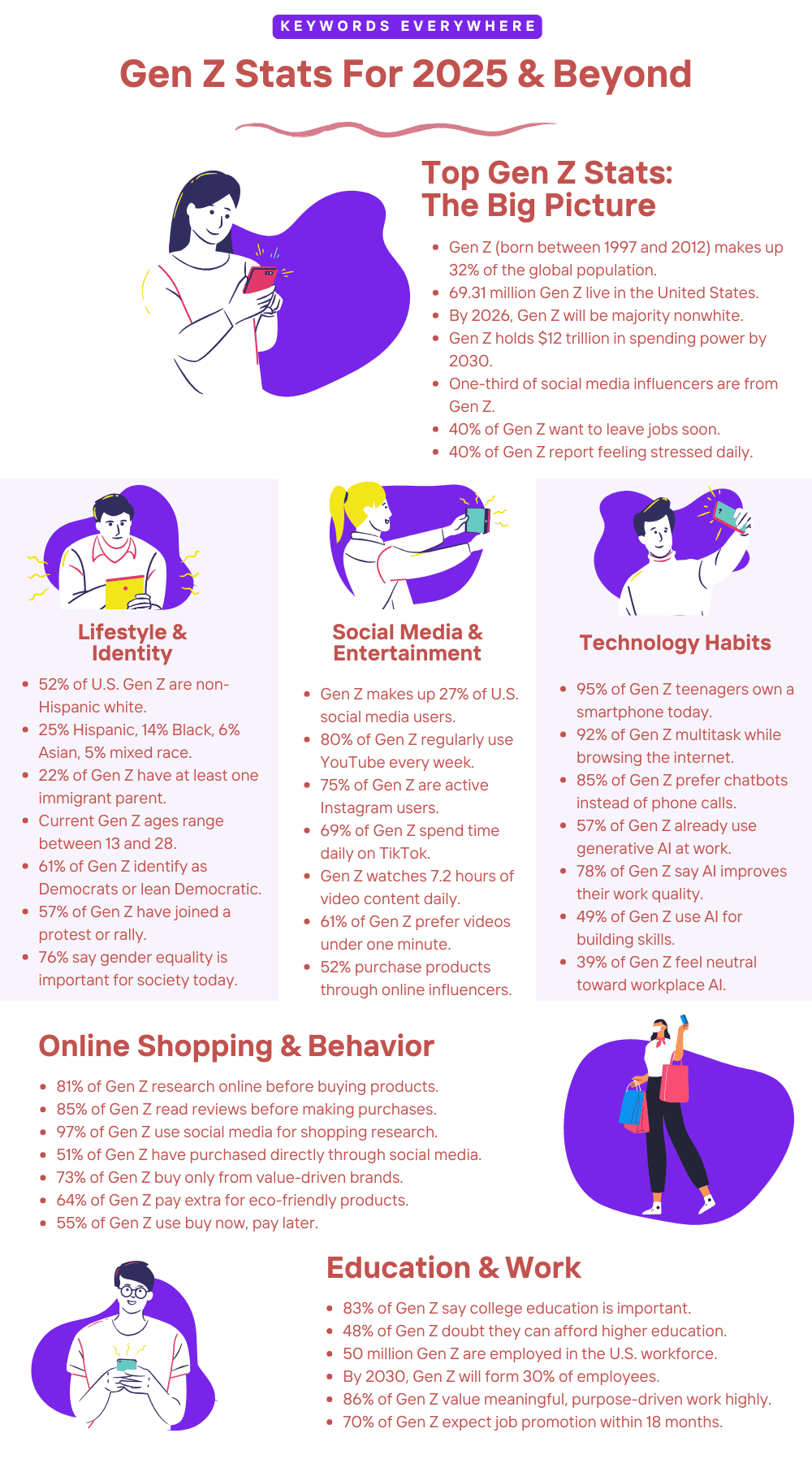
Top Gen Z Stats
Gen Z is no longer just the “younger generation” everyone talks about—they’re already shaping trends, driving consumer choices, and entering the workforce in huge numbers.
In 2025, this group makes up about a third of the world’s population, which means their influence is bigger than ever.
Here are the top Gen Z stats that give you a clear picture of how they think, what they value, and where they’re heading next.
1. There are 69.31 million people from Generation Z living in the United States.
2. YouTube and Instagram remain the most popular social platforms for Gen Z, though TikTok is quickly closing the gap.
3. Gen Z is the most racially and ethnically diverse generation in American history, and by 2026, they are expected to become the majority nonwhite.
4. The cost of living and mental health are the biggest concerns for Gen Z, and they are more likely than older generations to seek therapy or mental health services for support.
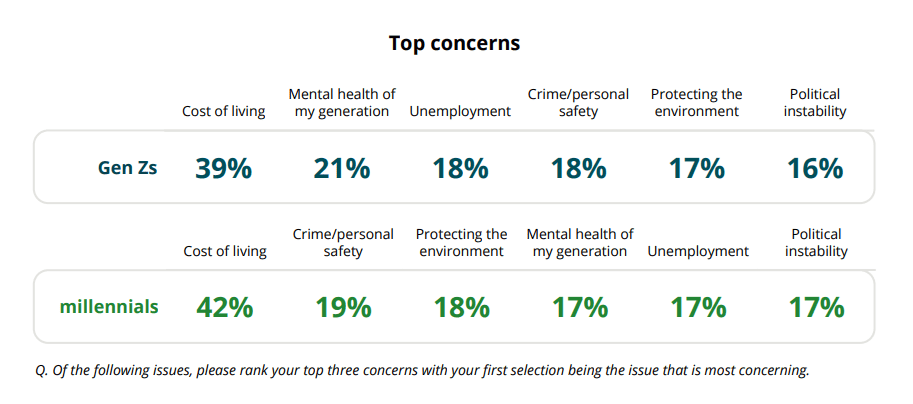
Top concerns of Gen Z vs Millennials
5. More than one-third of all social media influencers are part of Generation Z.
6. 40% of Gen Z say they plan to leave their current job within the next two years.
7. 40% of Gen Z also report feeling stressed or anxious most of the time.
8. Around half of Gen Z shop online at least once a month, another half purchase items only when they need them, and 33% prefer to wait for good deals or sales before buying.
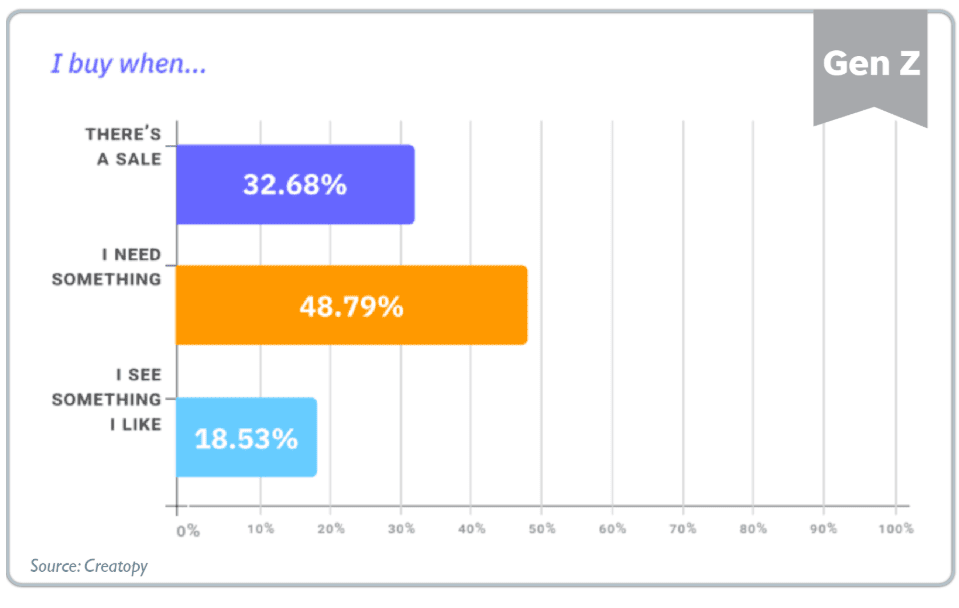
Gen Zers are not impulsive buyers
9. With 94% of Gen Z owning a smartphone, it is not surprising that 49% of Gen Z employees regularly use AI tools to improve their skills in different areas.
10. Gen Z has already earned the title of being the most purpose-driven generation, with 86% saying that having meaningful work is essential for their overall well-being and satisfaction.
11. Generation Z is currently the largest generational group, making up about 32% of the world’s total population.
12. According to Keywords Everywhere trend data, searches for “Gen Z” on Google only started appearing after 2013. They became much more popular after 2021, showing that while the generation was born between 1997 and 2012, the term itself took many years to gain attention.

Gen Z Demographics and Lifestyle Stats
What does the typical Gen Z look like today?
This generation is incredibly diverse, both culturally and socially, and their lifestyle choices reflect that mix.
From the way they view family and relationships to how they spend their free time, their habits show us how different they are from Millennials and older generations.
These Gen Z stats highlight what their everyday life really looks like right now.
13. Just over half of Gen Z (52%) are non-Hispanic white, which is a smaller share compared to Millennials in 2002, when 61% were non-Hispanic white.
14. About one in four Gen Zers are Hispanic, 14% are Black, 6% are Asian, and 5% identify as another race or as two or more races.
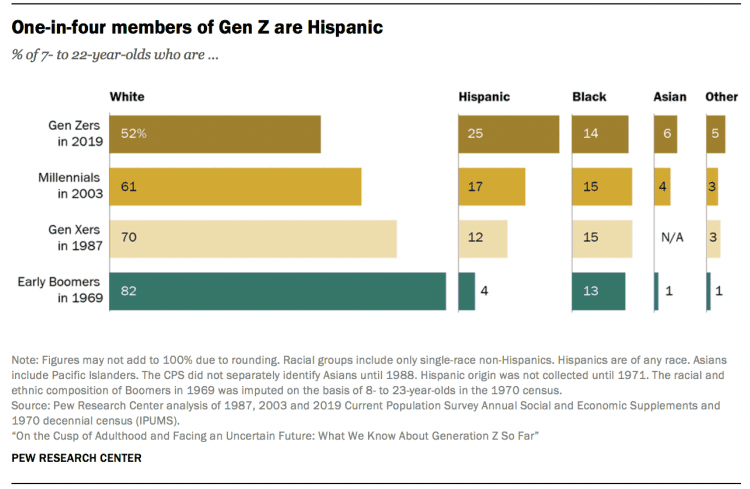
Gen Z race and ethnicity
15. Gen Z is slightly less likely to be immigrants compared to Millennials at the same age, with 6% born outside the U.S. compared to 7% of Millennials. However, 22% of Gen Z have at least one immigrant parent, while only 14% of Millennials did.
16. 49% of Gen Z teens say they want to attend college full-time after finishing high school. That number rises to 74% when we include those who would like to attend college part-time while working.
17. While 83% of Gen Z consider a college education to be very or fairly important, nearly half (48%) say they are not confident they will actually be able to afford it.
18. Depending on the year and region, the ages within Gen Z vary, but most people in this generation today fall between 13 and 28 years old.

Age range by generations
19. Gen Z spends more money per person than older generations did at the same age. Globally, their total spending power is expected to reach $12 trillion by the year 2030.
20. In relationships, 60% of Gen Z say being genuine matters more than looks, 65% believe open and honest communication is the most important factor, and 69% would choose emotional understanding over physical attraction in a partner.
21. Around 58% of Gen Z prefer meeting people through dating apps rather than in person, and 67% have used a dating app at least once.
22. Gen Z spends more time sleeping than any other generation, with a median of 9 hours and 42 minutes per day. They are also the most physically active, spending a median of 29 minutes each day on sports or exercise.
23. Compared to other generations, Gen Z is the most focused on health and appearance. They dedicate about 5 hours and 27 minutes every week to self-care activities.
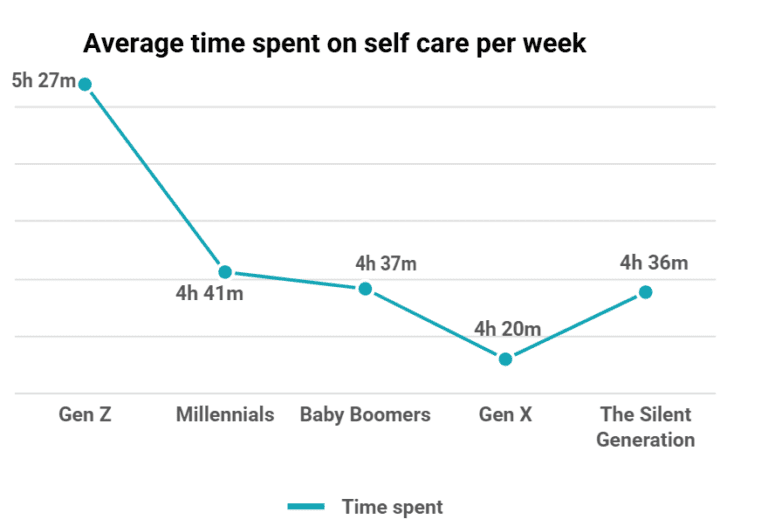
Average time spent on self care per week by different generations
24. Politically, Gen Z leans more toward progressive and liberal views, with about 61% identifying as Democrats or leaning Democratic.
25. Gen Z is highly engaged in activism, with 57% saying they have taken part in a protest or rally for a cause they believe in.
26. Seven in ten Gen Zers believe the government should play a bigger role in solving problems in the country. Only 29% think the government is already doing too much and that certain issues should be left to individuals and businesses instead.
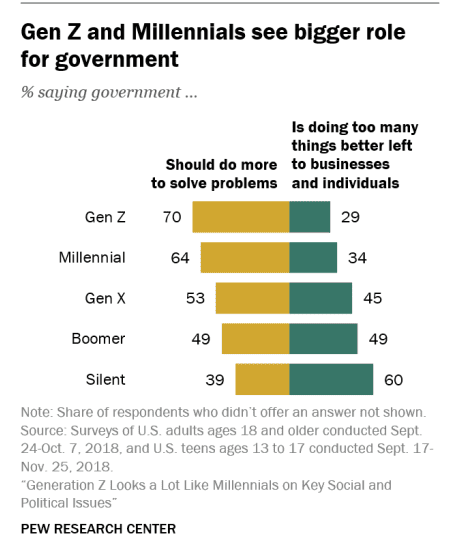
Majority of Gen Zers feel that government should do more to solve problems
27. A large majority of Gen Z (76%) believe gender equality is important and think society should be doing more to achieve it.
28. The same percentage, 76%, believe racial discrimination is a serious issue, and 70% say they support the Black Lives Matter movement and its goals.
Gen Z and Social Media Usage Stats
Scroll through TikTok, Instagram, or YouTube, and chances are, most of the content you see was made for or by Gen Z.
Social media is where this generation connects, learns, and even builds careers. But it’s not just about entertainment—they use these platforms for news, activism, and brand discovery too.
The following Gen Z stats show just how deeply social media is woven into their daily lives.
29. As of March 2025, adults from Generation Z made up 27% of the total social media audience in the United States. Among Gen Z users, the most common activities are liking and commenting on people’s posts.
30. Gen Z’s use of social media is growing faster than any other generation. In 2024, their usage increased by 7.7%, compared to an overall growth of just 1.8% among all U.S. users.
31. YouTube and Instagram remain the most popular platforms for Gen Z, with over 80% spending time on YouTube and 75% using Instagram. TikTok is close behind, with 69% of Gen Z spending time on the app.
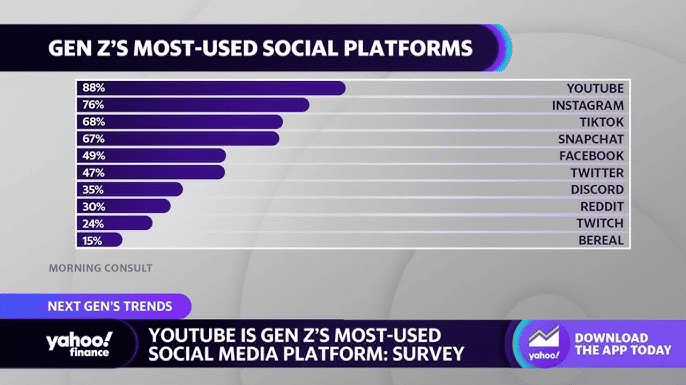
Most used social platforms by Gen Z
32. According to Semrush data, 79% of all YouTube users belong to Gen Z, while 39% of TikTok users are between the ages of 18 and 28.
33. About 68% of Gen Z say they use social media mainly for fun, such as watching videos and scrolling feeds, while only 19% use it primarily to message others.
34. Gen Zs watch an average of 7.2 hours of video content per day, switching between TikTok, YouTube, and Netflix. In comparison, Millennials watch about 205 minutes daily, while Gen X averages 169 minutes and Baby Boomers 136 minutes.
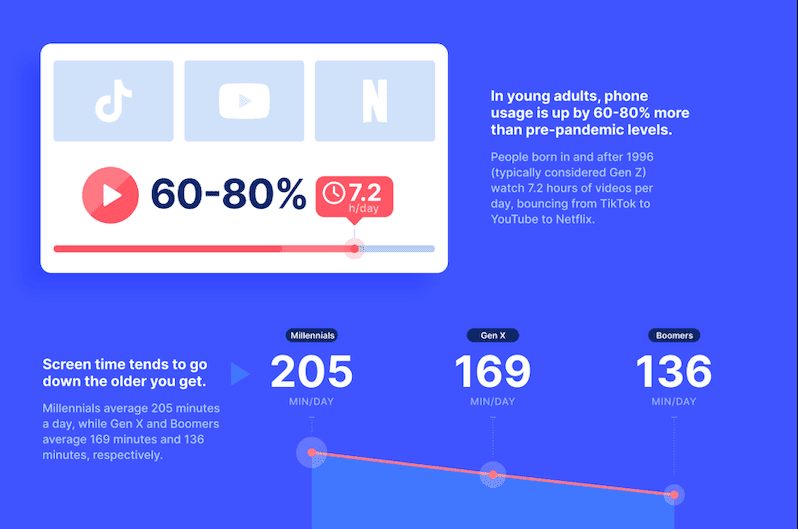
Gen Z watch video content for more than 7 hours
35. By 2025, Instagram is expected to reach 52.4 million Gen Z users in the U.S., which will be higher than the number of Millennials using the platform.
36. TikTok is becoming more than just an entertainment app for Gen Z. Since the fourth quarter of 2020, there has been a 104% increase in Gen Z using TikTok to research products and brands, and a 90% increase in using it as a news source.
37. Social media shopping is on the rise, with 52% of Gen Z making purchases through influencers they follow online, compared to 43% who buy directly from retailers.
38. A large share of Gen Z (67%) enjoy watching “storytime” videos where creators share personal experiences, while review videos are the most likely to lead to purchases, with 53% of viewers saying they bought a product after watching one.
39. Short videos are the clear favorite, with 61% of Gen Z preferring content under one minute long. Still, about 20% say they also watch videos that are longer than 30 minutes.

Gen Z video preferences
40. Cyberbullying is a serious issue for this generation, with around 59% of Gen Z reporting that they have witnessed someone being bullied online.
Gen Z and Technology Habits Stats
This is the first generation to grow up fully online, and it shows. Whether it’s video streaming, online gaming, or using AI tools (like ChatGPT), Gen Z is quick to adopt new tech and adapt to all these changes.
They’re comfortable moving between devices, juggling apps, and using digital shortcuts that older generations might still be catching up on.
Here are some important Gen Z stats that reveal how their tech habits are shaping the future.
41. In 2022, 95% of American teens between the ages of 13 and 17 had a smartphone, compared to just 73% in 2015. That’s a sharp 30% increase in only seven years.

Almost every teenager in 2022 had access to a smartphone
42. 43% say they remember the last website they visited more than their partner’s birthday. Ouch. Only 38% are more likely to remember their partner’s birthday than their last online click.
43. Multitasking is second nature to Gen Z, with 92% saying they browse the internet while doing something else. The most common pairings include eating (59%), listening to music (59%), and talking on the phone (45%).
44. 85% of Gen Z prefer using chat or automated interactions rather than making phone calls. That’s a big contrast to Baby Boomers, where just 58% rely on chat or automation for customer service needs.
45. A majority of Gen Z (57%) and millennials (56%) are already using generative AI at work to some extent. Within this group, about 30% of Gen Z and millennials report using it all or most of the time, which is up from 26% of Gen Z and 22% of millennials in 2024.
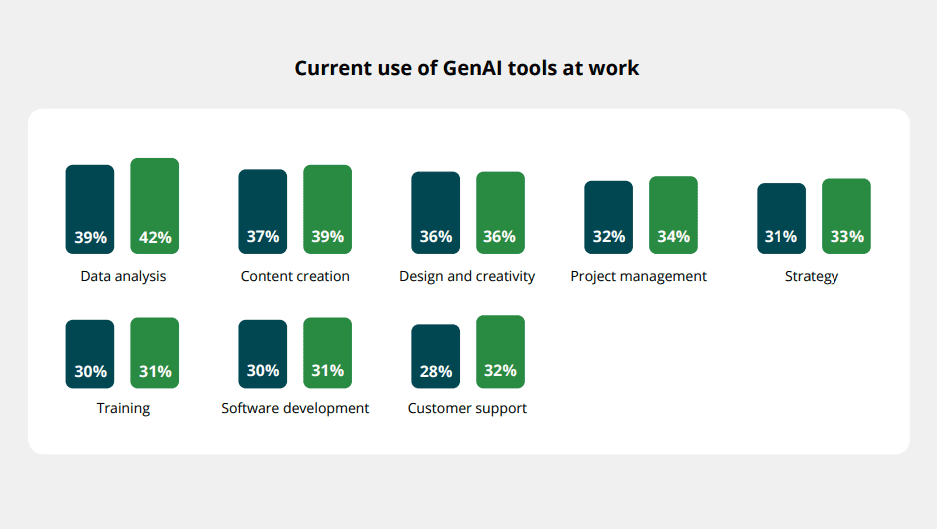
Use of GenAI tools at work by Gen Z and Millennials
46. Those already using generative AI in their jobs are largely positive about its impact. Among them, 78% of Gen Z and 82% of millennials say it has improved the quality of their work, while 77% of Gen Z and 79% of millennials feel it has saved them time and improved their work-life balance.
47. 28% of both Gen Z and millennials said Gen AI has simplified routine tasks and boosted efficiency. Around a quarter also noted improved productivity (25% of Gen Z and 26% of millennials) and greater creativity and innovation (25% of Gen Z and 24% of millennials).
48. 49% of Gen Z already use AI as a tool to build their skills. According to the NSHSS Career Interest Survey, the top uses are brainstorming (39%), proofreading (33%), and data analysis (21%).
49. Still, Gen Z’s feelings toward AI at work are mixed. A CAKE.com study found that 39.7% feel neutral about it, 25.9% view it positively, and 20.7% hold negative opinions about AI’s role in their workplace.

Gen Z opinions on AI
Gen Z Online Shopping and Consumer Behavior Stats
Shopping for Gen Z doesn’t just mean walking into a store—it’s swiping through a phone, checking for reviews, and sometimes even buying directly from brands on social media.
They care about convenience, speed, and whether a brand matches their values. With many skipping traditional ads in favor of influencers and peer recommendations, their behavior is rewriting the rules for businesses.
These Gen Z stats explain how their shopping choices are changing the market.
50. 81% of Gen Zers do online research before making a purchase, and 85% read reviews to guide their decisions. For 62%, reviews from people they personally know or trust matter most.
51. Before visiting in person, 64% of Gen Z check a local business’s website.
52. Social media dominates their shopping research habits, with 97% saying it’s their top method for exploring options.
53. Shopping directly through social media is already normal for Gen Z, with 51% having made a purchase this way. At the same time, 72% still say they prefer buying in physical stores.
54. A personalized shopping experience matters to 87% of Gen Z. The numbers look similar across generations—88% of millennials, 82% of Gen X, and 77% of boomers also want personalization.
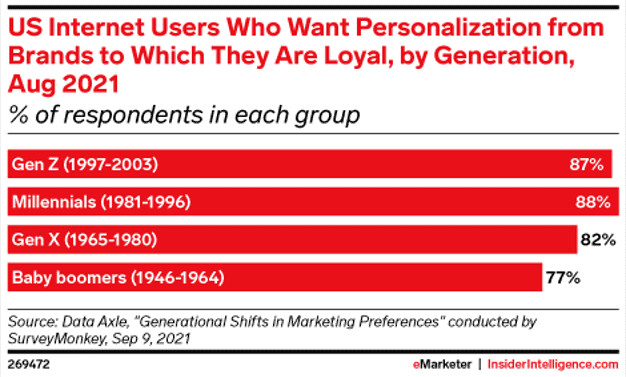
Gen Z want personalization
55. Brand values strongly influence Gen Z’s choices, with 73% saying they only buy from brands they believe in. For younger Gen Z (ages 14–17), that number is 84%, while for older Gen Z (ages 18–26), it’s 64%.
56. Trust is a deal-breaker for Gen Z shoppers—61% will pay more for brands they trust, and 71% will forgive and recommend brands they trust, even if the brand has made mistakes.
57. Over half (55%) of Gen Z say exclusive content like behind-the-scenes videos or tutorials makes a brand more appealing.
58. In 2023, one in five Gen Z consumers stopped buying from certain brands because of poor ethics or weak sustainability practices.
59. 33% of Gen Z adults and 13% of Gen Z teens actively avoid buying from companies they believe are unethical.

Gen Z attitude towards brand ethics
60. Even though 46% of Gen Z live paycheck to paycheck, 64% are still willing to pay more for environmentally friendly products.
61. Gen Z is also the most comfortable with “buy now, pay later” services compared to other generations, with 55% saying they’ll use this option at least once per year.
Gen Z in Education and Workforce Stats
Classrooms and workplaces are changing fast, and Gen Z is a big reason why.
They expect flexibility, digital tools, and environments that match the way they think and work.
Many are balancing school with side hustles, freelancing, or content creation, while those entering full-time jobs want meaning, growth opportunities, and a decent work-life balance.
The following Gen Z stats show how they’re reshaping both education and careers at the same time.
62. 40% of Gen Z and millennials who chose not to pursue higher education said financial constraints were one of the main reasons. For 34% of Gen Z and 42% of millennials, family or personal circumstances also influenced their decision.

Reasons why Gen Z does not want to pursue higher education
63. 61% of Gen Z prefer schools or programs that reflect their values, such as diversity, sustainability, and inclusion.
64. A majority of 68% believe learning real-world skills like coding, communication, or data analysis is more valuable than memorizing facts.
65. Gen Z is already a big part of the workforce, with 50 million employed in the U.S. alone. In 2023, 17.1 million Gen Zers entered the U.S. workforce.
66. By 2030, Gen Zers are projected to make up 30% of all employees, according to McKinsey’s Quarterly report.
67. Purpose-driven work is central to Gen Z, with 86% saying it’s key to their overall well-being and satisfaction, according to Deloitte.
68. Career growth expectations are high—70% of Gen Z expect to be promoted within their first 18 months on the job, Ripplematch research shows.
69. When choosing a job, 74% of Gen Z rank a high starting salary and job stability as their top priorities, according to Handshake.
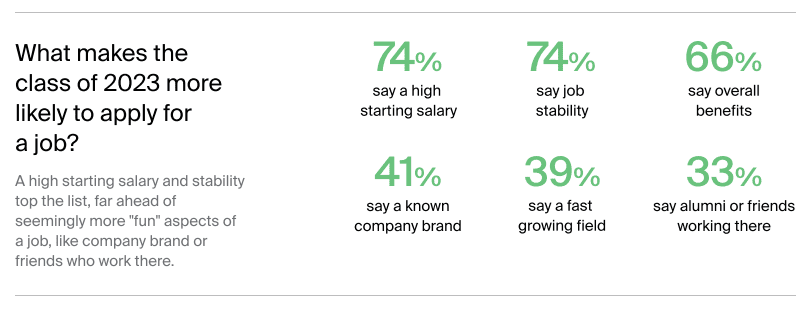
What makes Gen Z apply for a job
70. Mental health is also front of mind: 92% of Gen Z graduates want to discuss it at work, but only 56% feel comfortable doing so with their managers.
71. Values play a big role in employment decisions, with 44% of Gen Z saying they would turn down an employer if they noticed a misalignment with their beliefs, Deloitte reports.
72. 57% of Gen Z search for office-based roles, while only 27% say they prefer fully remote jobs.
Conclusion
If there’s one word that defines Gen Z, it’s different.
They think differently about work, education, shopping, and even politics.
They’re more outspoken about values, more willing to pay extra for sustainability, and more determined to see real-world skills and mental health taken seriously.
Gen Z isn’t shy about holding governments, brands, or employers accountable.
In the years ahead, their influence will only keep growing—and the way they reshape society will be impossible to ignore.


